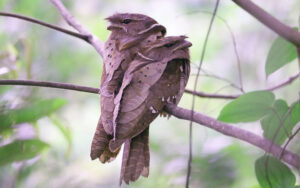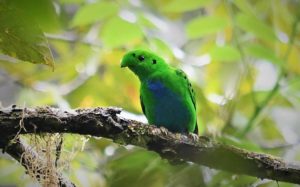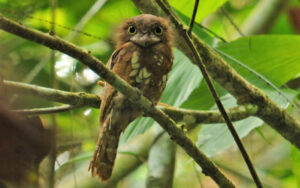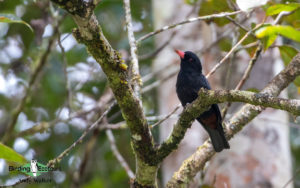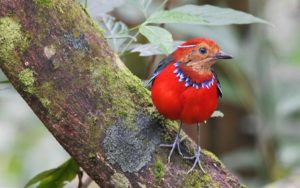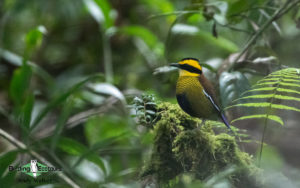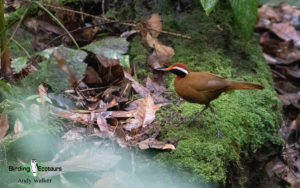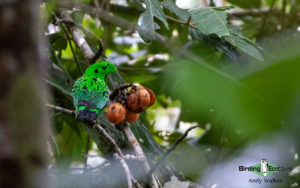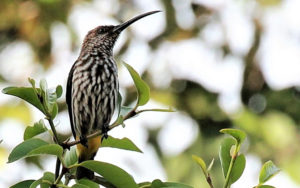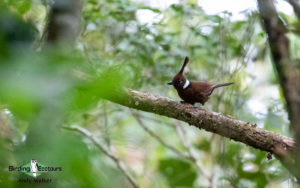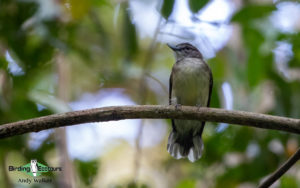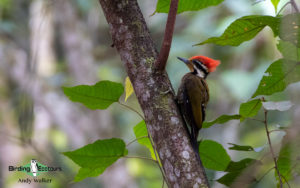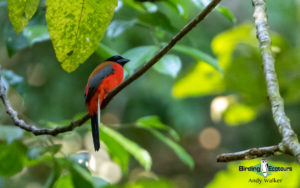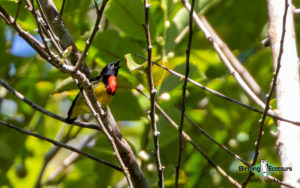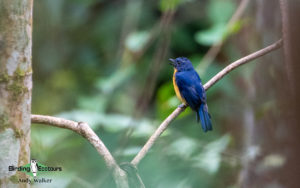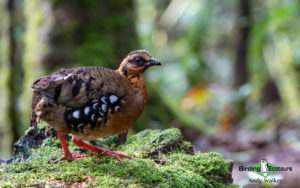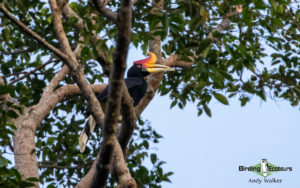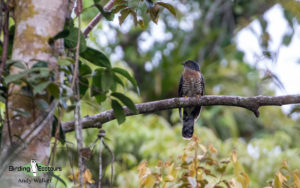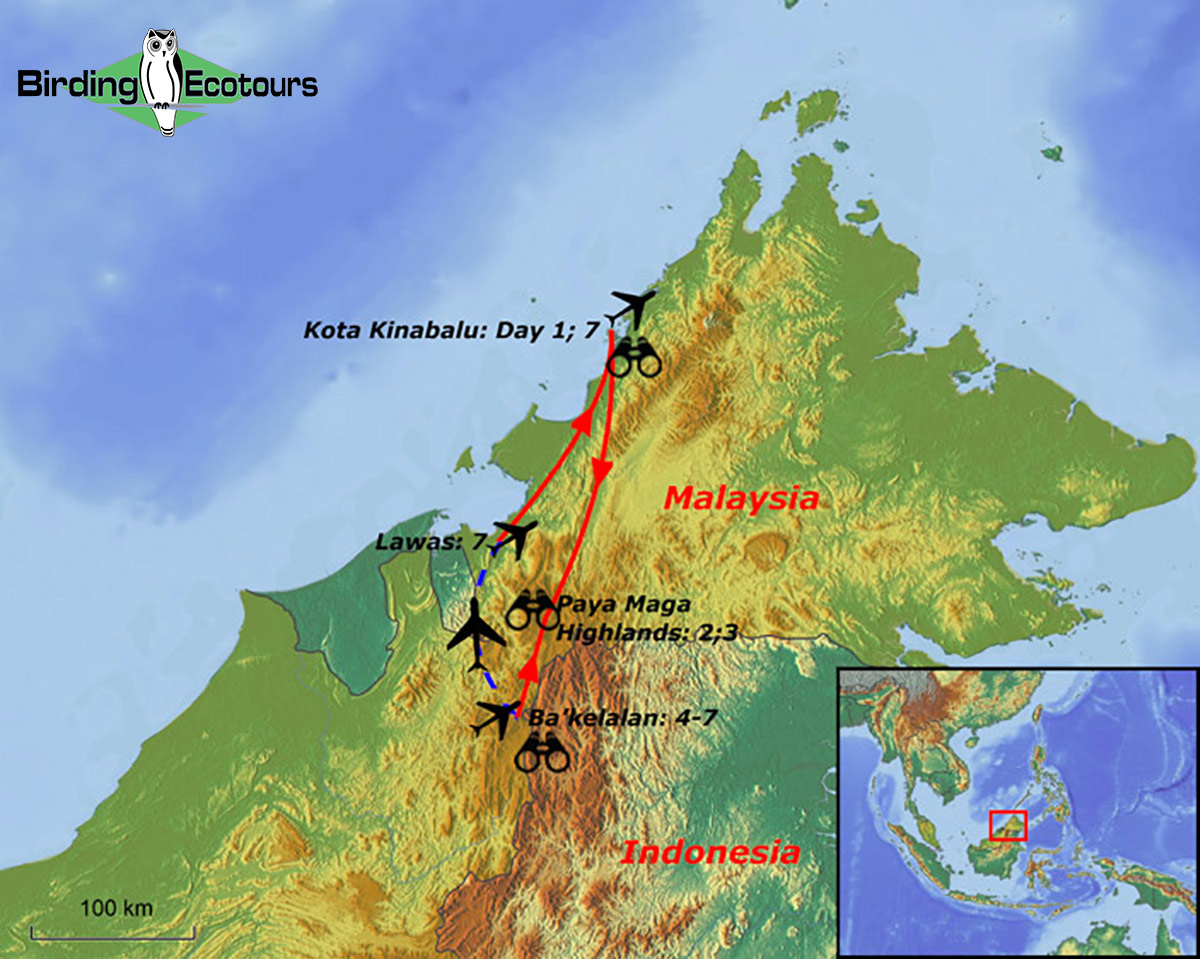Birding Tour Borneo : Sarawak – Restricted Range Endemics
Go to: Borneo Birding Tours | Malaysia Birding Tours | Birding Tours in Asia | All our birding tours
Birding Tour Borneo: Sarawak – Restricted Range Endemics
September 2025
The Malaysian province of Sarawak in Borneo takes more effort than neighboring Sabah, but we do not recommend missing Sarawak as it provides superior chances of seeing Blue-banded Pitta, Bornean Banded Pitta, Hose’s Broadbill, Bulwer’s Pheasant, Rail-babbler, and other absolute jewels that will burn your eyes. And we also will be looking for species we have no chance of seeing on our Sabah tour, such as Dulit Frogmouth, Bornean Frogmouth, and Black Oriole, all mega world birds of rather legendary status!
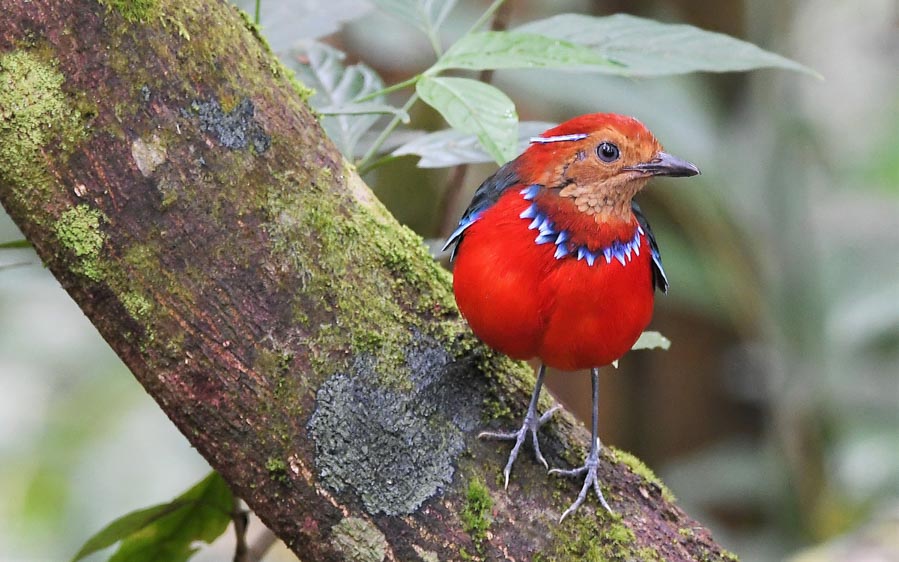
This short (seven-day) trip starts and ends in Kota Kinabalu in the neighboring Sabah province before crossing into Sarawak, where our birding is focused. This trip begins immediately after our Birding Tour Borneo: Sabah Classic Tour, and straight after this Sarawak tour there is our Birding Tour Malaysia: Peninsular Malaysia, which offers yet more spectacular birds.
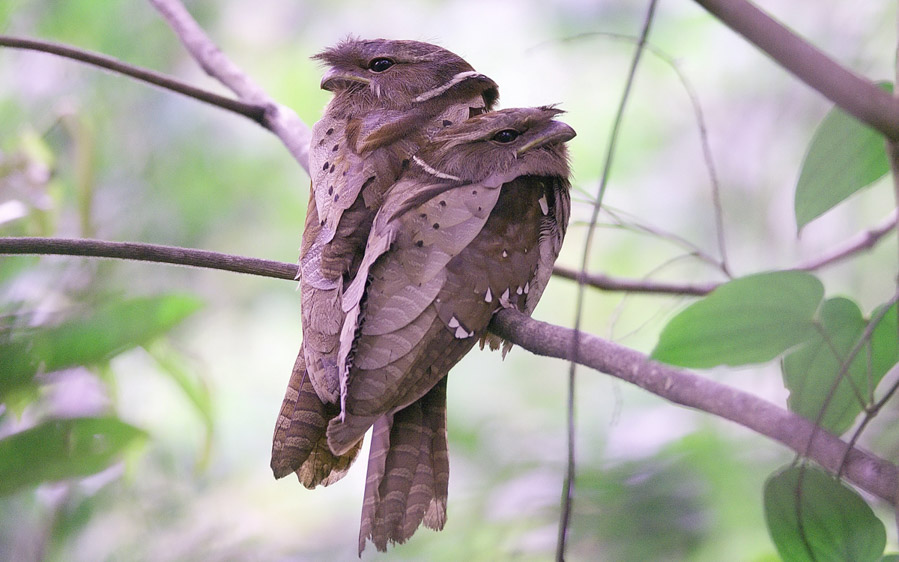
Itinerary (7 days/6 nights)
Day 1. Kota Kinabalu to Orang Ulu Village (via Klias Wetland)
In the morning we proceed from Kota Kinabalu to the Klias Wetlands, where we will look for Grey-breasted Babbler, Scarlet-breasted Flowerpecker, Red-crowned Barbet, and Chestnut-bellied Malkoha. One of our main targets here will be Hook-billed Bulbul, a specialist of peat swamp forest. After lunch in Lawas town we will travel overland in four-wheel-drive vehicles to Orang Ulu Village ahead of our next few days birding at Paya Maga.
Overnight: Orang Ulu Village homestay
Day 2. Paya Maga Highlands
After breakfast we will transfer to the Paya Maga Highlands drop-off point, from where we will slowly hike for four kilometers (two-and-a-half miles) along a gently undulating old logging road to our campsite, birding along the way. This beautiful montane forest area in remote northeastern Sarawak is home to many incredible species, and we will be on the lookout for a very special bird, none other than Black Oriole, a very rare Bornean endemic not found in Sabah.
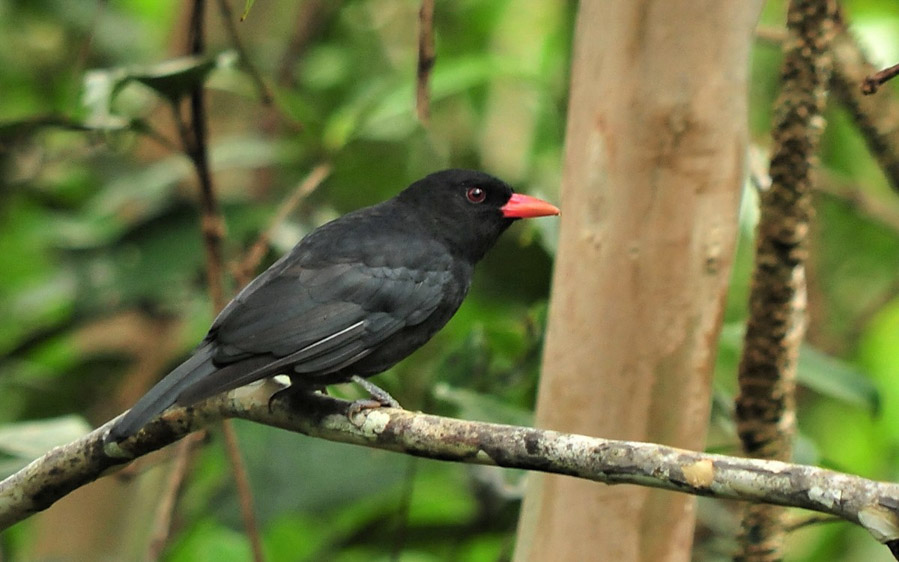
These highlands are covered in secondary forest with an abundance of Macaranga. We will bird the logging road from where it begins, then go beyond Gunung Doa at 850 meters (2,500 feet) to the base of the Paya Maga Camp Site at 1,050 meters (3,100 feet). The habitat along the road consists of mixed dipterocarp and lower montane forest. Occasional patches of undisturbed montane heath forest remain, particularly on the steepest slopes.
Targets during our hike will include Bulwer’s Pheasant along with Bornean Banded Pitta, Blue-banded Pitta, and Hose’s Broadbill, all stunning jewels. There are usually plenty of bulbuls, babblers, and flycatchers along the track, and other endemics may include Bornean Barbet and Bornean Leafbird.
In the evening we will look for Bornean Frogmouth, another endemic bird best looked for in Sarawak as opposed to Sabah.
Overnight: Paya Maga campsite wooden house
Day 3. Paya Maga Highlands
After breakfast we continue birding the Paya Maga Highlands, hoping to add species to our list that might include more endemics. We will look for Hose’s Broadbill, Bornean Leafbird, Bornean Bulbul, Pygmy White-eye, Banded Kingfisher (an endemic subspecies and potential future split), Bornean Treepie, Chestnut-crested Yuhina, and any of the other goodies that are around.
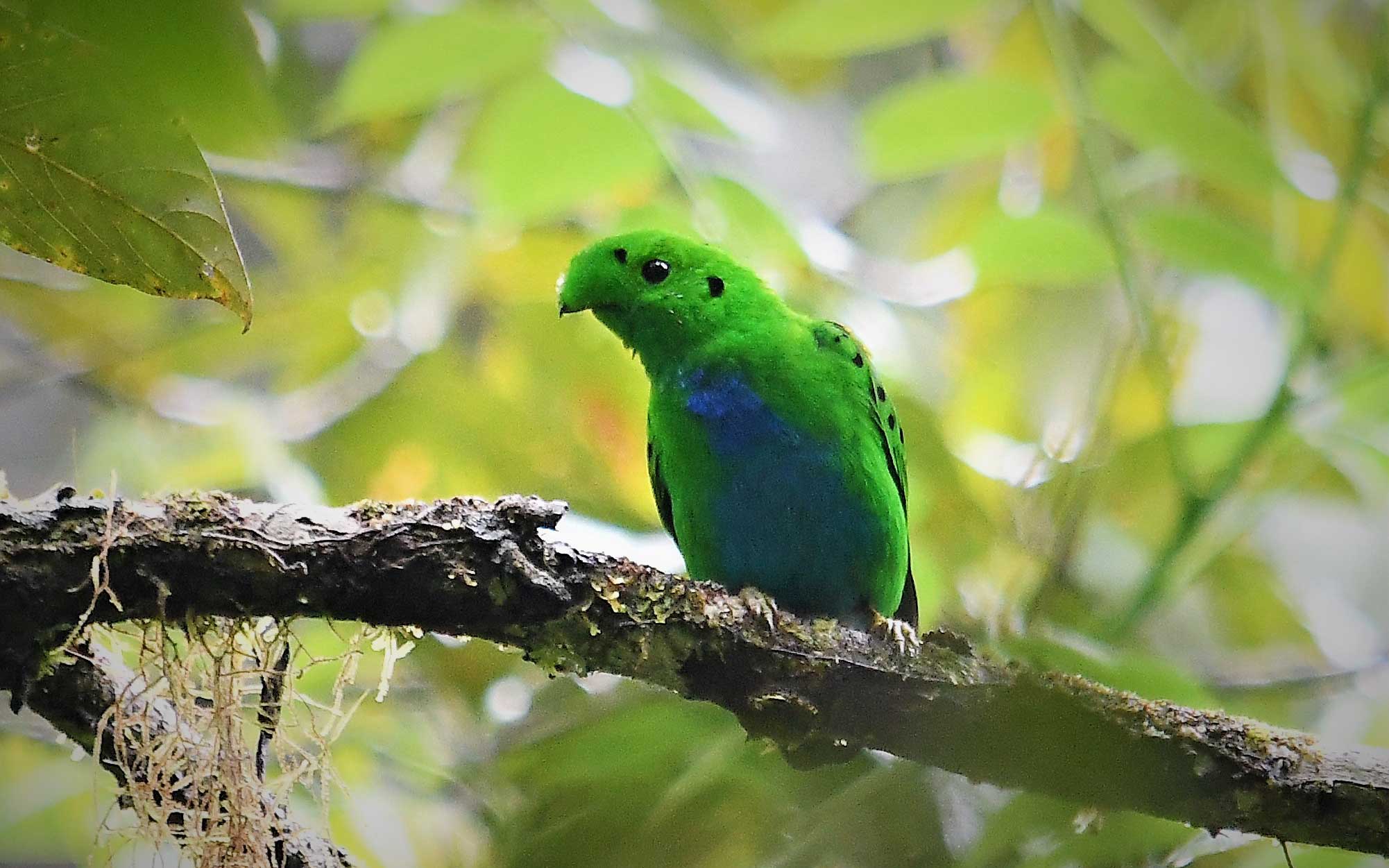
While not endemic, Rail-babbler is likely at the top of many birders’ wish-lists. Not only is it an incredible-looking species but it is also in a monotypic family, making it a must-see for any family lister. It is also extremely secretive and does not give itself up easily, although the sub-montane forest at Paya Maga is a good place to search for it.
We will also be sure to search for Javan Blue Flycatcher, until recently part of the Hill Blue Flycatcher complex. The subspecies of this new species that occurs in Borneo may potentially be further split as Dayak Blue Flycatcher in the near future, so this is one to be on the lookout for! Other species we will search for include Collared Owlet, Jambu Fruit Dove, White-necked Babbler, Eyebrowed Wren-Babbler, Temminck’s Babbler, the attractive Scaly-breasted Bulbul, Finsch’s Bulbul, Olive-backed Woodpecker, Rufous-collared Kingfisher, Diard’s Trogon, and Red-bearded Bee-eater. In the evening we will have another opportunity for Bornean Frogmouth if needed.
Overnight: Paya Maga campsite wooden house
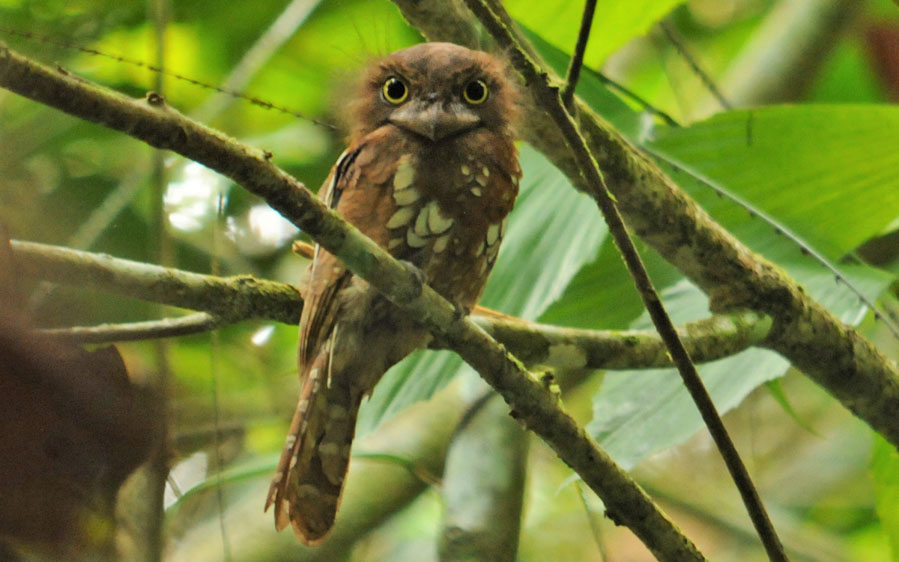
Day 4. Paya Maga Highlands to Ba’kelalan
We will have a final morning birding in the Paya Maga Highlands area, where we will be on the continuous lookout for new species, some of which may include Rufous-tailed Shama, Bornean Spiderhunter, Bare-headed Laughingthrush, and Flavescent Bulbul of the distinctive endemic subspecies sometimes referred to as Pale-faced Bulbul, another potential split.
On reaching the point we were dropped off on day 2 we will board our four-wheel drive vehicles again for a few hours as we travel to the Ba’kelalan area, where we will check into our homestay late in the afternoon. This homestay will serve as our base for the next three nights as we work the area for its special birds.
After dinner we will search for the highly prized Dulit Frogmouth in a nearby patch of forest.
Overnight: Ba’kelalan homestay
Days 5 – 6. Ba’kelalan area
We will have two full days birding in the Ba’kelalan area, home to some of Borneo’s classic, vibrant, and famous endemic birds. These include the likes of Whitehead’s Spiderhunter, Whitehead’s Broadbill, Hose’s Broadbill, Fruithunter, Bornean Green Magpie, Mountain Serpent Eagle, Black-throated Wren-Babbler, Bornean Stubtail, Bornean Spiderhunter, Bornean Barbet, Mountain Barbet, Golden-naped Barbet, Bare-headed Laughingthrush, Chestnut-hooded Laughingthrush, and Bornean Whistler – an impressive set of birds likely to get the juices flowing!
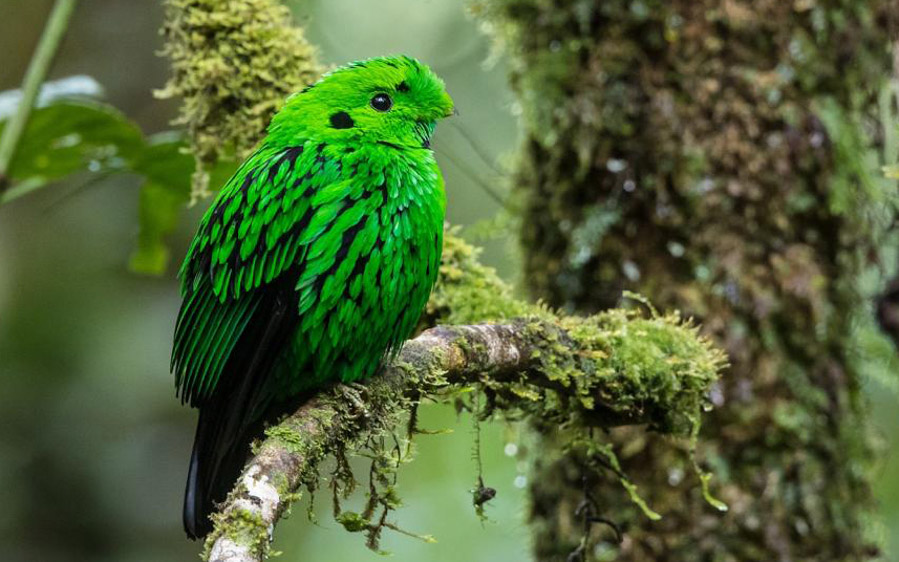
During our time in Ba’kelalan we also hope to encounter Long-tailed Broadbill, Rufous-tailed Jungle Flycatcher, Orange-breasted Trogon, and Dark Hawk Cuckoo in addition to the many species mentioned above. We will have plenty of time to look for all these exciting species and many more. Crimson-headed Partridge, Red-breasted Partridge, and Ferruginous Partridge all occur here but are often particularly secretive and therefore very tough to actually see. In addition to Dulit Frogmouth other night birds in the vicinity of the homestay may include Malaysian Eared Nightjar and Brown Hawk-Owl, so we will seek those out.
Overnight: Ba’kelalan homestay
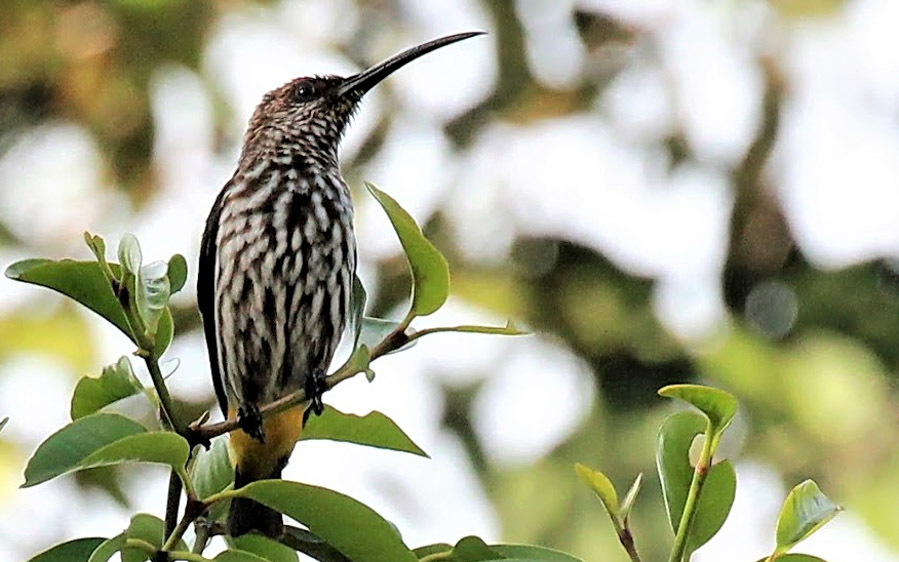
Day 7. Ba’kelalan to Kota Kinabalu (via Lawas)
We will have a final morning birding in the Ba’kelalan area, the exact timing of which will depend on the time of our flight between Ba’kelalan and Lawas. We may look around the village, where in the rice paddies and meadows we might find Greater Painted-snipe, Yellow Bittern, and Cinnamon Bittern, along with some other birds of the habitat.
After arrival in Lawas we will transfer back to Kota Kinabalu. The journey will take a few hours, and we aim to be back in the city in the late afternoon. If you plan on leaving Borneo on this day we recommend a late-evening flight; alternatively you could stay overnight (cost not included) and enjoy some hotel comforts after a week of exploring one of Asia’s greatest birding destinations.
Directly following this tour we start our Birding Tour Malaysia: Peninsular Malaysia, where we can see a very different set of birds to those seen on this tour, such as Mountain Peacock-Pheasant, Malayan Peacock-Pheasant, Ferruginous Partridge, Malayan Laughingthrush, Malayan Banded Pitta, Garnet Pitta, Blue-winged Pitta, Hooded Pitta, Mangrove Pitta, Common Green Magpie, Mangrove Blue Flycatcher, and many more!
Overnight: Not included
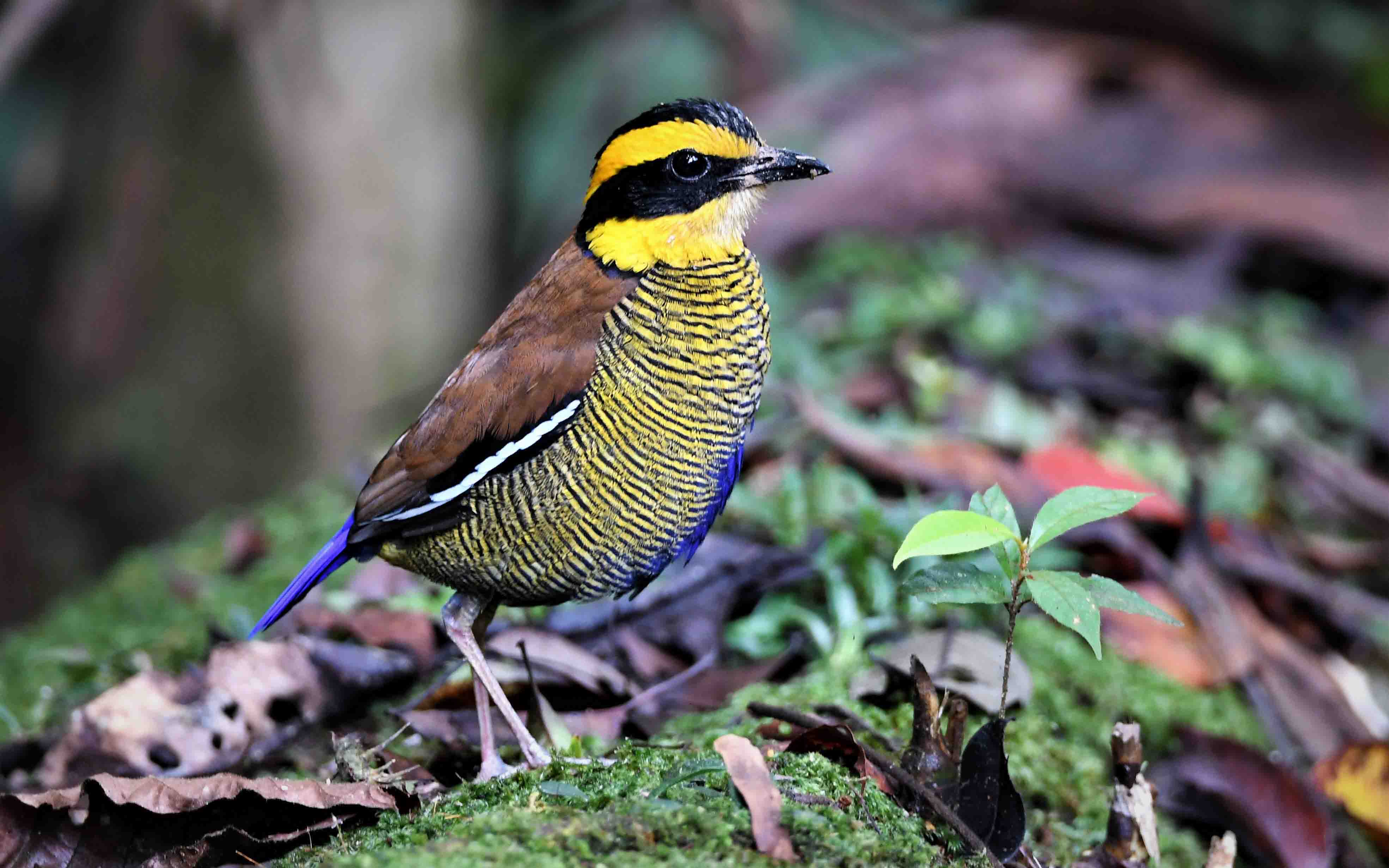
Please note that the itinerary cannot be guaranteed as it is only a rough guide and can be changed (usually slightly) due to factors such as availability of accommodation, updated information on the state of accommodation, roads, or birding sites, the discretion of the guides and other factors. In addition, we sometimes have to use a different international guide from the one advertised due to tour scheduling.
Download ItineraryMalaysia: Borneo, Sarawak – Restricted Range Endemics Set Departure Tour Trip Report
20 – 26 SEPTEMBER 2022
By Andrew Walker
DOWNLOAD TRIP REPORT
Overview
This short tour of Sarawak state started in Kota Kinabalu in neighboring Sabah state on the 20th of September 2022 and ended back there on the 26th of September 2022. We visited three areas on the tour, Klias Swamp (Klias Wetland) in Sabah for a morning, and Ba’kelalan and Paya Maga in Sarawak. Borneo had experienced a very wet period during what was meant to be the dry season, considered to be a result of the continuing La Niña phenomenon. In general, we were very lucky with the weather, with most rain falling during the evening, though we did lose a little time during a couple of afternoons and evening due to poor weather, and it made for some wet trails, particularly at Paya Maga.

The extremely localized Dulit Frogmouth was a top tour target and we enjoyed great views.
Some of the main highlights seen during the tour included Dulit Frogmouth, Bornean Frogmouth, Black Oriole, Hose’s Broadbill, Whitehead’s Broadbill, Whitehead’s Spiderhunter, Hook-billed Bulbul, and Bornean Banded Pitta, all seen well by everyone. Unfortunately, Blue-banded Pitta was only seen by a couple of people this time.
Other highlights seen, included Malaysian Honeyguide, Rail-babbler, Crested Jayshrike, Mountain Serpent Eagle, Bornean Bulbul, Charlotte’s Bulbul, Penan Bulbul, Cream-eyed Bulbul, Finsch’s Bulbul, Olive-backed Woodpecker, Bornean Treepie, Crocker Jungle Flycatcher, Dayak Blue Flycatcher, Black-throated Wren-Babbler, White-necked Babbler, Bornean Barbet, Mountain Barbet, Golden-naped Barbet, Bornean Spiderhunter, Yellow-rumped Flowerpecker, Black-sided Flowerpecker, and Scarlet-breasted Flowerpecker.
We also saw some interesting subspecies, including (Bornean/Black-faced) Banded Kingfisher, Golden-whiskered (Golden-faced) Barbet, Blue-eared (Black-eared) Barbet, Cinereous (Green-winged) Bulbul, (Kalimantan) Yellow-bellied Bulbul, Eye-browed (Whitehead’s) Wren-Babbler, and Brown (Bornean) Fulvetta, to name a few, lots of potential future splits!
We also found several species of small mammals and other taxa during this short Borneo birding tour. The trip lists for birds and everything else we identified follows the report.
Detailed Report
Day 1, 20th September 2022. Kota Kinabalu to Ba’kelalan via Klias Swamp
We departed Kota Kinabalu very early in the morning after everyone had assembled in the capital of Sabah state the previous evening. Our main objective of the day was to drive from Kota Kinabalu in Sabah to Ba’kelalan in the state of Sarawak, though we were to spend the morning birding at Klias Swamp (also known as Klias Forest Reserve or Klias Wetland) in Sabah, near the state border.
Our main target in Klias Swamp was the localized and often tough-to-find Hook-billed Bulbul, so we headed into the swamp along the boardwalk to look for them as soon as we’d had our picnic breakfast. Walking along the boardwalk we saw Pink-necked Green Pigeon, Thick-billed Green Pigeon, Bornean Black-capped Babbler, Chestnut-rumped Babbler, Grey-hooded Babbler, Red-billed Malkoha, Chestnut-bellied Malkoha, Raffles’s Malkoha, and Common Hill Myna. Once we got well into the boardwalk trail, we concentrated on our main target, and we were lucky with a pair of Hook-billed Bulbuls giving some really great views. Shy at first, they eventually came nice and close giving repeated views.
After we were all satisfied with our looks at this rather unique bulbul, we picked up many other species, including Red-crowned Barbet, Blue-throated Bee-eater, Black-winged Flycatcher-shrike, Buff-necked Woodpecker, Buff-rumped Woodpecker, Blue-crowned Hanging Parrot, and Long-tailed Parakeet. Several species of flowerpeckers and sunbirds were noted, with an immature male Scarlet-breasted Flowerpecker being the pick of the bunch, though only seen briefly by a few, other species included Scarlet-backed Flowerpecker, Yellow-rumped Flowerpecker, and Orange-bellied Flowerpecker, while sunbirds were represented by Brown-throated Sunbird, Olive-backed Sunbird, Van Hasselt’s Sunbird, Ruby-cheeked Sunbird, and Crimson Sunbird.
After our birding session, with the temperature soaring, we hit the road for our long journey to Ba’kelalan, where we arrived in the early evening.
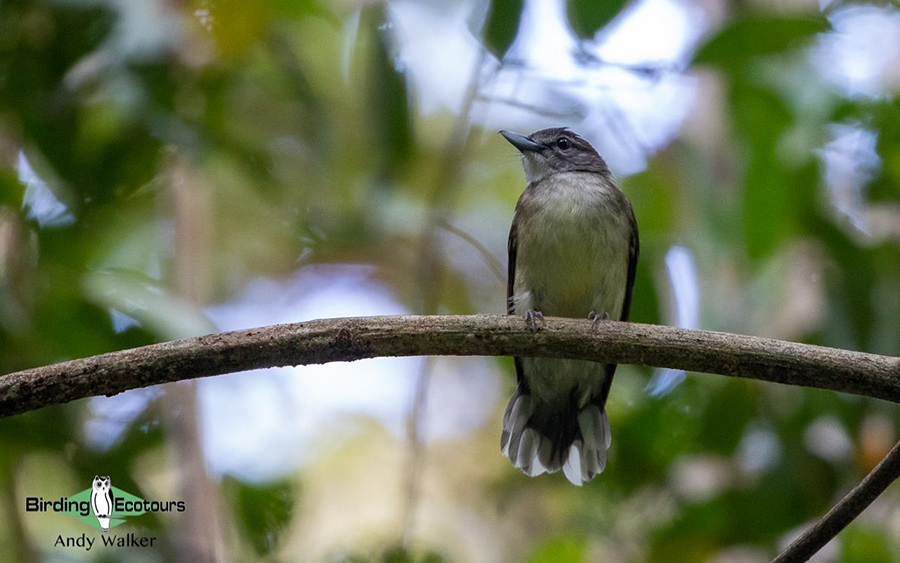
Hook-billed Bulbul can be a tough bird to connect with, so we were really happy with the excellent views we had of a few birds while birding in Klias Swamp.
Day 2, 21st September 2022. Birding Ba’kelalan area
We had an early start to try for nightbirds and our primary target was Dulit Frogmouth. Within no time at all we heard one calling and shortly thereafter had great eye-level views of this localized endemic, a large species, and one of the top targets for the tour. It was still just about dark, so we tried nearby for Bornean Frogmouth, another of our main target birds. We heard one calling but it was not seen, and we lost the darkness as the day dawned. We’d have to wait and hope for views of this one later. The sunlight did bring us our first Penan Bulbul and Ashy Drongo of the tour, along with a few other common species before we headed back to our homestay for breakfast.
We set off for a morning birding session around the Ba’kelalan area and enjoyed a great day. Our first stop in the forest gave us yet another of our major targets, Hose’s Broadbill. A female/young male flew right in above us. While in this area, we also found Bornean Spiderhunter, Crested Jayshrike (recently elevated to monotypic family status), and Bornean Treepie. A set of fruiting trees along the road yielded Bornean Barbet, Mountain Barbet, Green Broadbill, Black-and-yellow Broadbill, Black-headed Bulbul, Spectacled Bulbul, Scaly-breasted Bulbul, Bornean Bulbul, Cream-eyed Bulbul, Charlotte’s Bulbul, Cinereous (Green-winged) Bulbul, Asian Fairy-bluebird, Pygmy White-eye, and Yellow-rumped Flowerpecker.
Gaining some elevation, we birded a section of road right in the clouds that had recently descended. Here another big target bird nicely fell into place as we came across a pair of Whitehead’s Spiderhunters that came in to check us out. Unfortunately, the clouds were hindering views, but we could make out the distinguishing features well enough. As we walked down the mountain slope, we found Red-billed Malkoha, Golden-naped Barbet, Mountain Barbet, Black-and-crimson Oriole, Bornean Treepie, Chestnut-crested Yuhina, Chestnut-hooded Laughingthrush, Black-sided Flowerpecker, and Bornean Leafbird all attracted to some flowering and fruiting trees. Rhinoceros Hornbill and Orange-breasted Trogon were heard in the clouds, but unfortunately not seen.
The morning continued to deliver good views of great birds, including family parties of Dusky Broadbills and Olive-backed Woodpeckers and some work inside the forest gave us excellent views (eventually) of Black-throated Wren-Babbler and male Dayak Blue Flycatcher. With that it was time to head down the mountain for lunch and a siesta during the heat of the day.
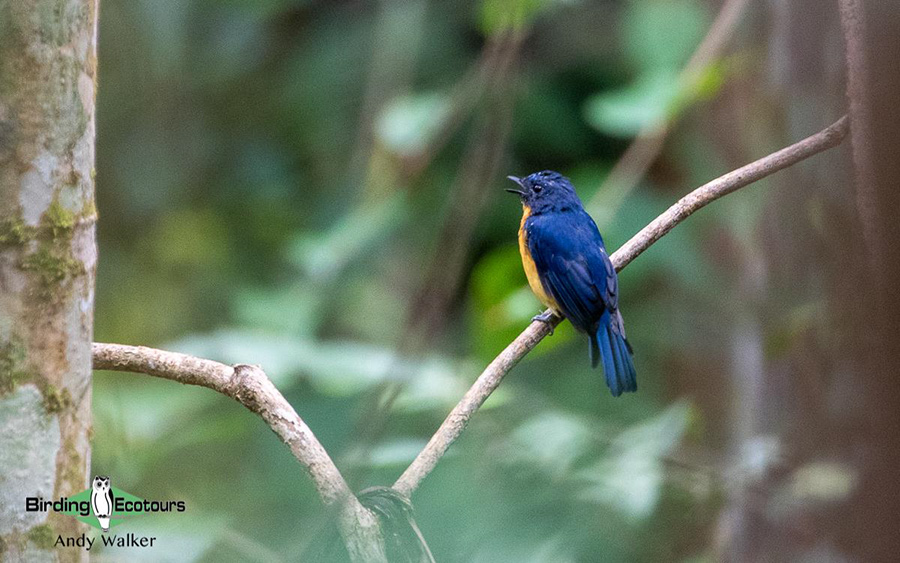
Dayak Blue Flycatcher gave us some nice views as it sang in the valley below us.
Our afternoon birding session gave us some more really good birds, with two of the best (after a lot of effort) being Rail-babbler, seen by most of the group, and the rare Blue-banded Pitta, seen by a couple of the group. Other quality birds seen included Banded Woodpecker, Wreathed Hornbill, and Black-thighed Falconet. In the evening we had a night-birding session seeing Horsfield’s (Western) Tarsier and Bornean Frogmouth, along with having an interesting chat with some Malaysian and Indonesian military personnel who were interested in what we were doing! This all ended what had been a truly remarkable day’s birding.

Our day started with great views of Dulit Frogmouth (see cover image) and ended with just as good views of Bornean Frogmouth (above)!
Day 3, 22nd September 2022. Birding Ba’kelalan area
Another excellent day was had birding the Ba’kelalan area. After breakfast we drove up to the nearby forest that had been so rewarding the previous day, here we found many of the species mentioned above, but also added plenty more. Some of the top birds from the morning included Red-breasted (Bornean) Partridge, Philippine Cuckoo-Dove, Square-tailed Drongo-Cuckoo, Rail-Babbler (seen again!), Greater Green Leafbird, Mountain Tailorbird, and a pair of Mountain Serpent Eagles.
Rain hit in the afternoon, and it persisted into the evening and made for a change of plans to our birding. We made the most of a small break in the rain while birding in a small clearing. Here we found Pink-necked Green Pigeon, Greater Coucal (where we witnessed the longest ever recorded flight of one!), Blue-eared Kingfisher, Blue-eared (Black-eared) Barbet, Golden-whiskered (Golden-faced) Barbet, and after a fair bit of effort, good views of Bold-striped Tit-Babblers! With the rain coming down hard we unfortunately couldn’t do any owling so it was off for dinner and bed.
Day 4, 23rd September 2022. Birding Ba’kelalan area travel to Long Tuyo
We had our final morning birding session in Ba’kelalan, and yet again it was a wonderful experience. The top highlight was easily the pair of Whitehead’s Broadbills that we had feeding in a fruit tree. What a spectacular bird! We spent a fair bit of time in the forest trying to improve our views of Hose’s Broadbill, sadly to no avail (and we were starting to really appreciate how lucky we had been on our first morning!), though we did find Eye-browed (Whitehead’s) Wren-Babbler and had a brief glimpse at Bornean Forktail. While waiting for Blue-banded Pitta, which we again heard but didn’t see, we had Chestnut-breasted Malkoha and Hairy-backed Bulbul, as well as Scarlet Minivet, Bornean Barbet, Mountain Barbet, Olive-backed Woodpecker, and Grey-streaked Flycatcher.
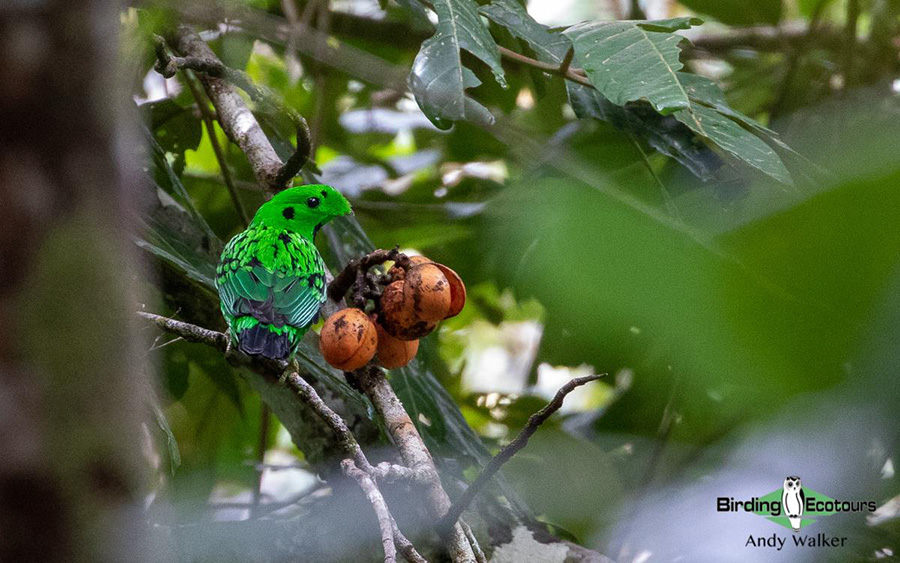
Busily feeding in a fruiting tree at eye-level, we enjoyed watching the gorgeous Whitehead’s Broadbill.
After lunch it was time to leave Ba’kelalan and drive to Long Tuyo, our base for the night before heading to the Paya Maga Highlands. We made a couple of roadside birding stops along the way, finding Dark Hawk-Cuckoo, Blyth’s Hawk-Eagle, and Black Eagle along the way. However, the best sighting was of a pair of Bornean Banded Pittas, yet another top target and spectacular bird seen fairly well. We arrived at our homestay for the night and could hear the distant call of Large Frogmouth, but it didn’t come in close and then a night of heavy rain followed.
Day 5, 24th September 2022. Birding Paya Maga Highlands
This was an enjoyable day trekking in remote Sarawak. We left our accommodation after breakfast and met up with our porters who would carry our essentials and some food up the mountain to our campsite for the next couple of nights. While organizing this we enjoyed watching a perched male Little Green Pigeon, an attractive start to the day (a bit better-looking than the Slender-billed (Sunda) Crows we had seen during breakfast!).
We got to our hike drop-off point and started birding. We were soon rewarded with good views of a host of quality birds, including (Bornean/Black-faced) Banded Kingfisher, White-necked Babbler, Ferruginous Babbler, Fluffy-backed Tit-Babbler, Yellow-bellied Bulbul, Grey-cheeked Bulbul, Finsch’s Bulbul, Purple-naped Sunbird, Plain Sunbird, and Greater Green Leafbird. While taking a break about halfway along the trail to our campsite we could hear Malaysian Hawk-Cuckoo, but it wouldn’t come close, and we also watched a pair of Dark-sided Flycatchers foraging. Suddenly pandemonium broke out as we realized a pair of rarely seen Malaysian Honeyguides had flown in right overhead and moved around us, giving their incredible and distinctive call. We were all thrilled with this unexpected bonus bird and a little in shock.
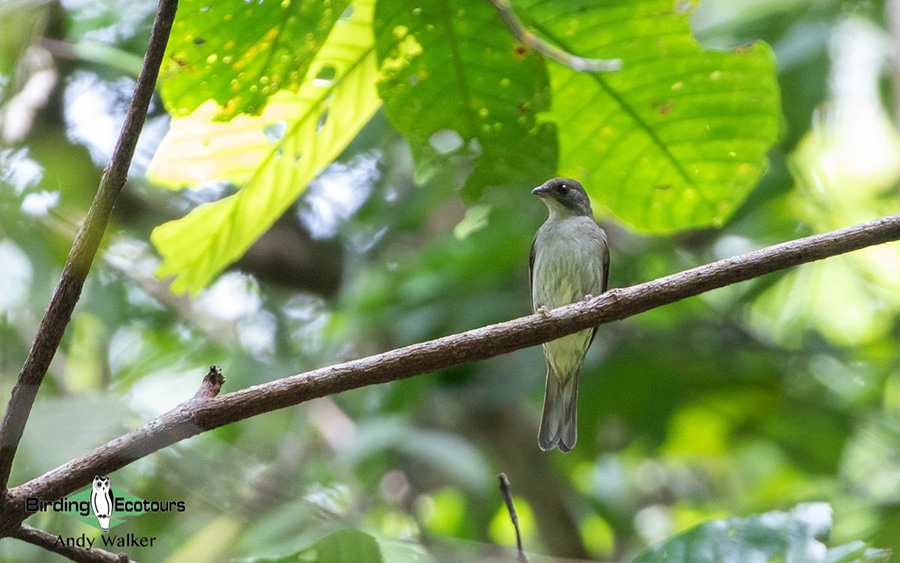
A real surprise highlight of our trek up to Paya Maga, and one of the biggest of the entire tour, was the moment when a pair of Malaysian Honeyguides flew in and landed right above us!
Buoyed by the amazing honeyguide experience we completed the second half of our hike to the campsite, adding a few new birds along the way, including Blyth’s Hawk-Eagle and the attractive Whiskered Treeswift.
We unpacked our camp and had lunch, though this was disturbed when a Black Oriole – our main target bird for this camping trip was heard calling. Unfortunately, we didn’t see it this time, but needn’t have worried as an hour or so later a pair of birds came by again and this time were close enough to see, and to see well as they foraged right in front of us, seemingly unconcerned by our presence. This sighting must rate as one of the best of the tour, given the looks we had and the history of the species.

We had amazing sightings of Black Oriole near our campsite. What a bird!
Afternoon birding around the campsite yielded a mix of species, including Bornean Leafbird, Bar-winged Flycatcher-shrike, Bornean Barbet, Hair-crested (Bornean Spangled) Drongo, Crimson-winged Woodpecker, Maroon Woodpecker, Buff-necked Woodpecker, Buff-rumped Woodpecker, and more views of Black Oriole.
The day had proven a real highlight of the tour, with some top-quality birds recorded throughout, and set in a beautiful landscape too. After dinner it was time for an early night.
Day 6, 25th September 2022. Birding Paya Maga Highlands
Our final full day birding around the Paya Maga Highlands was spent in some beautiful forest, though at times the birds were few and far between and difficult to catch up with, typical of forest birding anywhere in the world and why we love the challenge of birding! The main highlight of the morning was a male Bornean Banded Pitta. This bird gave some great views perched up on a log as we were continuing our search for Hose’s Broadbill and Blue-banded Pitta to no avail. Walking through the forest we did see Rhinoceros Hornbill, Hair-crested (Bornean Spangled) Drongo, Rufous-chested Flycatcher, Grey-headed Canary-flycatcher, and Rufous-fronted Babbler. Unfortunately, the vocal Bornean Forktail mainly stayed out of sight, apart from a few flight views.
After a short tea break, we took a walk through another section of the forest below our accommodation. This resulted in us bumping into a mixed flock containing a few new trip birds and some better looks at a few other species, such as Maroon-breasted Philentoma, White-bellied Erpornis, Spotted Fantail, along with Black Oriole, Bornean Bulbul, Penan Bulbul, Crimson-winged Woodpecker, Black-naped Monarch, Sunda Scimitar Babbler, Dark-sided Flycatcher, and Bornean Leafbird.

This male Bornean Banded Pitta looked glorious in its forest setting.
During the afternoon birding session, we retraced some of the morning birding spots. As we stood outside our campsite area getting ready to leave, we had a rather showy Banded Bay Cuckoo pay us a visit, and Crested Jayshrikes were vocal but remained out of sight (we’d had great views of this species already so that was no problem).
We hiked up a nearby hill and saw a pair of Checker-throated Woodpeckers that showed fairly well. Shortly later, we were watching a pair of Penan Bulbuls and just as everyone had got good views of them a bit of extra activity started up, firstly some Bar-winged Flycatcher-shrikes and a male Black Oriole, but then a big highlight when the scarce Crocker Jungle Flycatcher (a recent split from Rufous-tailed Jungle Flycatcher) appeared in front of us and showed well for the group.
While we were discussing the taxonomy of the jungle flycatcher, a movement right in front of us caught our attention. An adult male Hose’s Broadbill, finally! We then spent the next 30 minutes or so trying to get everyone in the group satisfactory views of this great and localized tough Bornean endemic, securing better views than the bird earlier in the trip (which wasn’t as attractive as this absolute stunner!). Very happy with our haul and with the light fading we returned down the hill to our campsite, with a flock of Wreathed Hornbills passing over at dusk. This was a great end to our final full day of birding of the tour.
Day 7, 26th September 2022. Paya Maga Highlands to Kota Kinabalu, where tour concluded
After breakfast we hiked back down the mountain from our campsite to the drop-off point. As we walked down, we continued our birding, finding a few new birds along the way, including Red-bearded Bee-eater, Lesser Green Leafbird, Plain Flowerpecker, and a family party of Scarlet-rumped Trogons. We also got better views of Fluffy-backed Tit-Babbler than we did on the way up the mountain a few days before.
We left the area in the late-morning and drove back to Kota Kinabalu via a lunch stop in the town of Lawas, arriving in Kota Kinabalu in the early evening when this short but endemic-filled and rather successful tour concluded. Some of the group continued on a private tour to look for the enigmatic Bulwer’s Pheasant (please contact us if you’d like to look for this world rarity), while some others continued on our wonderful Borneo: Sabah Classic Tour.
A huge thank you to our local guide Yeo for all of his amazing work during the tour, as well as to our drivers, porters, and family hosts, all who helped make the tour thoroughly enjoyable.

A record shot of the male Hose’s Broadbill that occasionally gave some good views but was, typically, rather shy.
Bird List – Following IOC (12.1)
Birds ‘heard only’ are marked with (H) after the common name, all other species were seen. The following notation after species names is used to show conservation status following BirdLife International: CR = Critically Endangered, EN = Endangered, VU = Vulnerable. The common name for Bornean endemics is shown in bold type, e.g., Whitehead’s Broadbill.
| Common Name | Scientific Name |
| Pheasants & Allies (Phasianidae) | |
| Red-breasted Partridge | Arborophila hyperythra |
| Great Argus – VU (H) | Argusianus argus |
| Nightjars (Caprimulgidae) | |
| Malaysian Eared Nightjar (H) | Lyncornis temminckii |
| Frogmouths (Podargidae) | |
| Large Frogmouth (H) | Batrachostomus auritus |
| Dulit Frogmouth | Batrachostomus harterti |
| Bornean Frogmouth | Batrachostomus mixtus |
| Treeswifts (Hemiprocnidae) | |
| Grey-rumped Treeswift | Hemiprocne longipennis |
| Whiskered Treeswift | Hemiprocne comata |
| Swifts (Apodidae) | |
| Plume-toed Swiftlet | Collocalia affinis |
| Edible-nest Swiftlet | Aerodramus fuciphagus |
| Cuckoos (Cuculidae) | |
| Greater Coucal | Centropus sinensis |
| Raffles’s Malkoha | Rhinortha chlorophaea |
| Red-billed Malkoha | Zanclostomus javanicus |
| Chestnut-breasted Malkoha | Phaenicophaeus curvirostris |
| Chestnut-bellied Malkoha | Phaenicophaeus sumatranus |
| Black-bellied Malkoha | Phaenicophaeus diardi |
| Banded Bay Cuckoo | Cacomantis sonneratii |
| Plaintive Cuckoo | Cacomantis merulinus |
| Rusty-breasted Cuckoo | Cacomantis sepulcralis |
| Square-tailed Drongo-Cuckoo | Surniculus lugubris |
| Dark Hawk-Cuckoo | Hierococcyx bocki |
| Malaysian Hawk-Cuckoo (H) | Hierococcyx fugax |
| Pigeons, Doves (Columbidae) | |
| Rock Dove (Feral Pigeon) | Columba livia dom. |
| Spotted Dove | Spilopelia chinensis |
| Philippine Cuckoo-Dove | Macropygia tenuirostris |
| Little Cuckoo-Dove | Macropygia ruficeps |
| Common Emerald Dove | Chalcophaps indica |
| Zebra Dove | Geopelia striata |
| Little Green Pigeon | Treron olax |
| Pink-necked Green Pigeon | Treron vernans |
| Thick-billed Green Pigeon | Treron curvirostra |
| Green Imperial Pigeon | Ducula aenea |
| Rails, Crakes & Coots (Rallidae) | |
| White-breasted Waterhen | Amaurornis phoenicurus |
| Sandpipers, Snipes (Scolopacidae) | |
| Common Sandpiper | Actitis hypoleucos |
| Gulls, Terns, Skimmers (Laridae) | |
| Whiskered Tern | Chlidonias hybrida |
| Anhingas, Darters (Anhingidae) | |
| Oriental Darter | Anhinga melanogaster |
| Herons, Bitterns (Ardeidae) | |
| Cinnamon Bittern | Ixobrychus cinnamomeus |
| Eastern Cattle Egret | Bubulcus coromandus |
| Great Egret | Ardea alba |
| Intermediate Egret | Ardea intermedia |
| Kites, Hawks, Eagles (Accipitridae) | |
| Crested Honey Buzzard | Pernis ptilorhynchus |
| Crested Serpent Eagle | Spilornis cheela |
| Mountain Serpent Eagle – VU | Spilornis kinabaluensis |
| Blyth’s Hawk-Eagle | Nisaetus alboniger |
| Black Eagle | Ictinaetus malaiensis |
| Lesser Fish Eagle | Haliaeetus humilis |
| Trogons (Trogonidae) | |
| Scarlet-rumped Trogon | Harpactes duvaucelii |
| Orange-breasted Trogon | Harpactes oreskios |
| Hornbills (Bucerotidae) | |
| Rhinoceros Hornbill – VU | Buceros rhinoceros |
| Helmeted Hornbill – CR (H) | Rhinoplax vigil |
| Black Hornbill – VU (H) | Anthracoceros malayanus |
| Bushy-crested Hornbill (H) | Anorrhinus galeritus |
| Wreathed Hornbill – VU | Rhyticeros undulatus |
| Kingfishers (Alcedinidae) | |
| Banded Kingfisher | Lacedo pulchella |
| Blue-eared Kingfisher | Alcedo meninting |
| Oriental Dwarf Kingfisher (H) | Ceyx erithaca |
| Bee-eaters (Meropidae) | |
| Red-bearded Bee-eater | Nyctyornis amictus |
| Blue-throated Bee-eater | Merops viridis |
| Asian Barbets (Megalaimidae) | |
| Golden-whiskered Barbet | Psilopogon chrysopogon |
| Red-crowned Barbet | Psilopogon rafflesii |
| Mountain Barbet | Psilopogon monticola |
| Golden-naped Barbet | Psilopogon pulcherrimus |
| Blue-eared Barbet | Psilopogon duvaucelii |
| Bornean Barbet | Psilopogon eximius |
| Honeyguides (Indicatoridae) | |
| Malaysian Honeyguide | Indicator archipelagicus |
| Woodpeckers (Picidae) | |
| Banded Woodpecker | Chrysophlegma miniaceum |
| Checker-throated Woodpecker | Chrysophlegma mentale |
| Crimson-winged Woodpecker | Picus puniceus |
| Olive-backed Woodpecker | Gecinulus rafflesii |
| Maroon Woodpecker | Blythipicus rubiginosus |
| Buff-rumped Woodpecker | Meiglyptes tristis |
| Buff-necked Woodpecker | Meiglyptes tukki |
| Caracaras, Falcons (Falconidae) | |
| Black-thighed Falconet | Microhierax fringillarius |
| Old World Parrots (Psittaculidae) | |
| Long-tailed Parakeet – VU | Psittacula longicauda |
| Blue-crowned Hanging Parrot | Loriculus galgulus |
| Typical Broadbills (Eurylaimidae) | |
| Dusky Broadbill | Corydon sumatranus |
| Black-and-yellow Broadbill | Eurylaimus ochromalus |
| African & Green Broadbills (Calyptomenidae) | |
| Green Broadbill | Calyptomena viridis |
| Hose’s Broadbill | Calyptomena hosii |
| Whitehead’s Broadbill | Calyptomena whiteheadi |
| Pittas (Pittidae) | |
| Bornean Banded Pitta | Hydrornis schwaneri |
| Blue-banded Pitta | Erythropitta arquata |
| Vangas & Allies (Vangidae) | |
| Bar-winged Flycatcher-shrike | Hemipus picatus |
| Black-winged Flycatcher-shrike | Hemipus hirundinaceus |
| Maroon-breasted Philentoma | Philentoma velata |
| Woodswallows, Butcherbirds & Allies (Artamidae) | |
| White-breasted Woodswallow | Artamus leucorynchus |
| Ioras (Aegithinidae) | |
| Green Iora | Aegithina viridissima |
| Cuckooshrikes (Campephagidae) | |
| Scarlet Minivet | Pericrocotus speciosus |
| Lesser Cuckooshrike | Lalage fimbriata |
| Shrikes (Laniidae) | |
| Long-tailed Shrike | Lanius schach |
| Vireos, Greenlets, Shrike-babblers (Vireonidae) | |
| White-bellied Erpornis | Erpornis zantholeuca |
| Figbirds, Orioles, Turnagra (Oriolidae) | |
| Black-and-crimson Oriole | Oriolus cruentus |
| Black Oriole | Oriolus hosii |
| Drongos (Dicruridae) | |
| Greater Racket-tailed Drongo | Dicrurus paradiseus |
| Hair-crested Drongo | Dicrurus hottentottus |
| Ashy Drongo | Dicrurus leucophaeus |
| Fantails (Rhipiduridae) | |
| Malaysian Pied Fantail | Rhipidura javanica |
| Spotted Fantail | Rhipidura perlata |
| Monarchs (Monarchidae) | |
| Black-naped Monarch | Hypothymis azurea |
| Blyth’s Paradise Flycatcher | Terpsiphone affinis |
| Jayshrike (Platylophidae) | |
| Crested Jayshrike | Platylophus galericulatus |
| Crows, Jays (Corvidae) | |
| Bornean Treepie | Dendrocitta cinerascens |
| Slender-billed Crow | Corvus enca |
| Rail-babbler (Eupetidae) | |
| Rail-babbler | Eupetes macrocerus |
| Fairy Flycatchers (Stenostiridae) | |
| Grey-headed Canary-flycatcher | Culicicapa ceylonensis |
| Bulbuls (Pycnonotidae) | |
| Hairy-backed Bulbul | Tricholestes criniger |
| Hook-billed Bulbul – VU | Setornis criniger |
| Yellow-bellied Bulbul | Alophoixus phaeocephalus |
| Grey-cheeked Bulbul | Alophoixus tephrogenys |
| Penan Bulbul | Alophoixus ruficrissus |
| Finsch’s Bulbul | Iole finschii |
| Charlotte’s Bulbul | Iole charlottae |
| Cinereous Bulbul | Hemixos cinereus |
| Streaked Bulbul | Ixos malaccensis |
| Black-headed Bulbul | Brachypodius melanocephalos |
| Spectacled Bulbul | Ixodia erythropthalmos |
| Scaly-breasted Bulbul | Ixodia squamata |
| Bornean Bulbul | Rubigula montis |
| Cream-vented Bulbul | Pycnonotus simplex |
| Asian Red-eyed Bulbul | Pycnonotus brunneus |
| Cream-eyed Bulbul | Pycnonotus pseudosimplex |
| Yellow-vented Bulbul | Pycnonotus goiavier |
| Swallows, Martins (Hirundinidae) | |
| Pacific Swallow | Hirundo tahitica |
| Barn Swallow | Hirundo rustica |
| Cettia Bush Warblers & Allies (Cettiidae) | |
| Mountain Tailorbird | Phyllergates cucullatus |
| Cisticolas & Allies (Cisticolidae) | |
| Yellow-bellied Prinia | Prinia flaviventris |
| Dark-necked Tailorbird | Orthotomus atrogularis |
| Ashy Tailorbird | Orthotomus ruficeps |
| White-eyes (Zosteropidae) | |
| Chestnut-crested Yuhina | Staphida everetti |
| Pygmy White-eye | Heleia squamifrons |
| Hume’s White-eye | Zosterops auriventer |
| Babblers, Scimitar Babblers (Timaliidae) | |
| Bold-striped Tit-Babbler | Mixornis bornensis |
| Fluffy-backed Tit-Babbler | Macronus ptilosus |
| Grey-hooded Babbler | Cyanoderma bicolor |
| Rufous-fronted Babbler | Cyanoderma rufifrons |
| Sunda Scimitar Babbler | Pomatorhinus bornensis |
| Chestnut-rumped Babbler | Stachyris maculata |
| Grey-throated Babbler (H) | Stachyris nigriceps |
| Grey-headed Babbler | Stachyris poliocephala |
| White-necked Babbler | Stachyris leucotis |
| Ground Babblers (Pellorneidae) | |
| Black-throated Wren-Babbler | Turdinus atrigularis |
| Sooty-capped Babbler (H) | Malacopteron affine |
| Bornean Black-capped Babbler | Pellorneum capistratoides |
| Temminck’s Babbler | Pellorneum pyrrogenys |
| Ferruginous Babbler | Pellorneum bicolor |
| Eyebrowed Wren-Babbler | Napothera epilepidota |
| Alcippe Fulvettas (Alcippeidae) | |
| Brown Fulvetta | Alcippe brunneicauda |
| Laughingthrushes & Allies (Leiothrichidae) | |
| Chestnut-hooded Laughingthrush | Pterorhinus treacheri |
| Fairy-bluebirds (Irenidae) | |
| Asian Fairy-bluebird | Irena puella |
| Starlings, Rhabdornis (Sturnidae) | |
| Asian Glossy Starling | Aplonis panayensis |
| Common Hill Myna | Gracula religiosa |
| Chats, Old World Flycatchers (Muscicapidae) | |
| Oriental Magpie-Robin | Copsychus saularis |
| White-rumped Shama | Copsychus malabaricus |
| Grey-streaked Flycatcher | Muscicapa griseisticta |
| Dark-sided Flycatcher | Muscicapa sibirica |
| Pale Blue Flycatcher | Cyornis unicolor |
| Dayak Blue Flycatcher | Cyornis montanus |
| Crocker Jungle Flycatcher | Cyornis ruficrissa |
| Verditer Flycatcher | Eumyias thalassinus |
| Bornean Forktail | Enicurus borneensis |
| Rufous-chested Flycatcher | Ficedula dumetoria |
| Leafbirds (Chloropseidae) | |
| Greater Green Leafbird – EN | Chloropsis sonnerati |
| Lesser Green Leafbird | Chloropsis cyanopogon |
| Bornean Leafbird | Chloropsis kinabaluensis |
| Flowerpeckers (Dicaeidae) | |
| Yellow-rumped Flowerpecker | Prionochilus xanthopygius |
| Scarlet-breasted Flowerpecker | Prionochilus thoracicus |
| Yellow-vented Flowerpecker | Dicaeum chrysorrheum |
| Orange-bellied Flowerpecker | Dicaeum trigonostigma |
| Plain Flowerpecker | Dicaeum minullum |
| Black-sided Flowerpecker | Dicaeum monticolum |
| Scarlet-backed Flowerpecker | Dicaeum cruentatum |
| Sunbirds (Nectariniidae) | |
| Ruby-cheeked Sunbird | Chalcoparia singalensis |
| Plain Sunbird | Anthreptes simplex |
| Brown-throated Sunbird | Anthreptes malacensis |
| Van Hasselt’s Sunbird | Leptocoma brasiliana |
| Olive-backed Sunbird | Cinnyris jugularis |
| Crimson Sunbird | Aethopyga siparaja |
| Temminck’s Sunbird | Aethopyga temminckii |
| Purple-naped Sunbird | Kurochkinegramma hypogrammicum |
| Little Spiderhunter | Arachnothera longirostra |
| Yellow-eared Spiderhunter | Arachnothera chrysogenys |
| Bornean Spiderhunter | Arachnothera everetti |
| Whitehead’s Spiderhunter | Arachnothera juliae |
| Old World Sparrows, Snowfinches (Passeridae) | |
| Eurasian Tree Sparrow | Passer montanus |
| Waxbills, Munias & Allies (Estrildidae) | |
| Scaly-breasted Munia | Lonchura punctulata |
| Dusky Munia | Lonchura fuscans |
| Chestnut Munia | Lonchura atricapilla |
| Wagtails, Pipits (Motacillidae) | |
| Grey Wagtail | Motacilla cinerea |
| Paddyfield Pipit | Anthus rufulus |
| Total seen | 179 |
| Total heard only | 10 |
| Total recorded | 189 |
Mammal List
| Common Name | Scientific Name |
| Squirrels (Sciuridae) | |
| Least Pygmy Squirrel | Exilisciurus exilis |
| Borneo Black-banded Squirrel | Callosciurus orestes |
| Jentink’s Squirrel | Sundasciurus jentinki |
| Pale Giant Squirrel | Ratufa affinis |
| Mongooses (Herpestidae) | |
| Short-tailed Mongoose | Urva brachyura |
| Treeshrews (Tupaiidae) | |
| Mountain Treeshrew | Tupia montana |
| Old World Monkeys (Cercopithecidae) | |
| Long-tailed Macaque | Macaca fascicularis |
| Silvery Lutung | Trachypithecus cristatus |
| Gibbons (Hylobatidae) | |
| Northern (North Bornean) Grey Gibbon | Hylobates funereus |
| Tarsiers (Tarsiidae) | |
| Horsfield’s (Western) Tarsier | Cephalopachus bancanus |
| Total | 10 |
Reptile List
| Common Name | Scientific Name |
| Monitors (Varanidae) | |
| Roughneck Monitor | Varanus rudicollis |
| Total | 1 |
Notable Other Taxa List
Not exhaustive, just a few of the interesting taxa identified incidentally during the tour. Several rather distinct stick insects were seen but yet to be identified.
| Common Name | Scientific Name |
| Ants (Formicidae) | |
| Giant Forest Ant | Dinomyrmex gigas borneensis |
| Katydids (Tettigoniidae) | |
| Leaf (Lichen) Katydid sp. | Trachyzulpha fruhstorferi |
| Scarabs (Scarabaeidae) | |
| Moellenkampi Beetle | Chalcosoma moellenkampi |
| Swallowtails and Parnassians (Papilionidae) | |
| Raja Brooke’s Birdwing | Trogonoptera brookiana |
| Malayan Birdwing | Troides amphrysus |
| Great Mormon Swallowtail | Papilio memnon |
| Brush-footed Butterflies (Nymphalidae) | |
| Giant Tree Nymph | Idea lynceus |
| Total | 7 |
DOWNLOAD TRIP REPORT
This is a sample trip report. Please email us ([email protected]) for more trip reports from this destination.
MALAYSIA: BORNEO – SARAWAK RESTRICTED RANGE ENDEMICS
TOUR-SPECIFIC INFORMATION
GENERAL INFORMATION ABOUT MALAYSIA (INCLUDING BORNEO) CAN BE READ HERE
TOUR OUTLINE
Sarawak is not to be missed, it offers the best chance in the world of finding Dulit Frogmouth, Bornean Frogmouth, and Black Oriole, as well as great birds like Blue-banded Pitta, Bornean Banded Pitta, Hose’s Broadbill, Bulwer’s Pheasant, and Rail-babbler. This tour starts and ends in Kota Kinabalu (in neighboring Sabah) and visits Klias wetland, the Paya Maga highlands, and Ba’kelalan. This tour runs with a nice small group with a minimum of four and a maximum of just six, giving everyone a much better birding experience than you would get on a large group tour.
DAILY ACTIVITIES, PHYSICAL REQUIREMENTS, AND TOUR PACE
This is a more remote tour than our other Bornean (Sabah) birding tour, with high avian rewards. It requires reasonable physical fitness and a sense of adventure. We will be staying in basic accommodation (homestays and camping) mainly with shared facilities, will have long hikes of three to five hours on muddy and possibly slippery trails most days, and will travel about in 4×4 vehicles on rough roads (there will be long drives in 4×4 vehicles to get between birding locations). Expect some night birding too, probably with early starts and late finishes, so all in all, we will be having long days in the field with little rest time. We are likely to experience a range of temperatures as we cover different elevations on the tour from lowlands to highlands.
TRANSPORTATION
We will be using 4×4 vehicles to get around on this tour. Roads are generally rough and not very good, with the going being quite slow at times, resulting in long travel times.
We will take a domestic flight back to Kota Kinabalu at the end of the tour.
DOMESTIC FLIGHTS
A domestic flight between Ba’kelalan and Lawas is included in the tour cost, but note that at the time of writing (February 2022) that flight may not be currently operating – due to Covid. So, if the flight is not operational, we may have to reorder the route of the tour and use 4×4 vehicles a little more to get around the wider region.
The domestic flight is likely to have a hold luggage weight limit of 44 pounds (20 kilograms) and a hand luggage allowance of 15 pounds (7 kilograms). Any overweight baggage will likely incur costs and will be the responsibility of the individual. Excess baggage costs will most likely need to be paid in cash to the airline at the airport.
LUGGAGE
Please pack as lightly as possible for this tour (noting the expected weight allowance of the domestic flight). A medium, soft-sided, and robust duffle bag is likely to work best for packing in the tour vehicles. A small daypack will be required for when we go out hiking during the day, to keep a personal supply of food and water for the day as well as other essential items such as rain gear, insect repellant, etc.
SAFETY
Your safety is our paramount concern on this, and all of our tours, so we are trying to provide you with as much information as possible within this tour-specific information and the Malaysia general information. Our tour takes us to a remote part of Sarawak.
The most likely issues on this tour are trips and falls when on trails, tracks/roads, and getting into or out of the 4×4 vehicles and so extra care should be taken at all times. Sturdy walking shoes, hiking boots or even rubber boots (wellington boots) are recommended for this tour. A hiking pole or walking stick is compulsory if you are at all unsure on your feet.
There is a low risk of malaria on Sarawak, but please consult your doctor or local travel clinic for specific advice. We will be spending time birding in areas where mosquitos occur. Insect repellent with a high DEET concentration can be useful for keeping them away and reducing the chance of mosquito bites. DEET or citronella insect spray can also keep chiggers and leeches away. Chiggers can lead to Scrub (Bush) Typhus and can be incredibly irritating. Leeches do not spread diseases, but they are rather unnerving and can cause blood loss and are particularly evident in Borneo. “Leech socks” are a useful piece of kit.
WEATHER/CLIMATE
In the mountains it is cooler than the lowlands and we can expect average daytime temperature highs of around 84 °F (29 °C) and average nighttime lows of 63 °F (17 °C) but the temperature may drop to below 59 °F (15 °C) occasionally. Note we will be in basic accommodation so you might feel the cold a bit more than if you were in a typical western-style building.
While in the lowlands we can expect average daytime highs of around 88 °F (31 °C) and average nighttime lows of 72 °F (22 °C). There is often thick cloud cover here, resulting in hot and humid, rather oppressive conditions.
Be aware that the sun is strong here and care should be taken to remain hydrated and use sun protection. Rain is possible at any time at any location so rain gear and an umbrella will be essential. A dry bag is also recommended for protecting optics, electrical equipment/cameras, and important documents. For more information on packing lists, see the “What to Bring: Clothing and Other Items” section below.
ACCOMMODATION
The accommodation on this tour is of a very basic standard and we will stay in homestays and camp in tents (within buildings) and these will have shared very basic bathroom facilities and toilets. The water pressure will be low for showering with limited hot water – most likely hot water at the homestay will be on request with hot water mixed into a pail of cold water for showering. You will need to bring a travel towel. There should be fans available at the homestay.
ELECTRICITY
Power cuts are frequent and some of the places we stay run on diesel generators. It would be advisable to bring a power bank for charging small personal items like smart phones etc.
COMMUNICATIONS
There is limited phone signal where we will be birding in Sarawak and there will not be any Wi-Fi along the tour route. You can purchase a local travel SIM card on arrival at the airport (Maxis SIM is probably the best for this tour). Alternatively, you can use your own provider on a roaming package, but please be aware there will likely be charges for this.
FOOD AND MEALS
Food is basic and of local Malaysian style. Vegetarian food can be arranged but please let us know of any dietary requirements ahead of the tour. Due to the lack of refrigeration, dairy products are not common. We suggest you bring your favorite snacks or protein bars to supplement your diet.
MONEY
We will only have access to ATMs in Kota Kinabalu on this tour. You shouldn’t require too much spare cash on this tour, but it is usually best to withdraw some cash when at the airport.
WHAT TO BRING: CLOTHING AND OTHER ITEMS
The following is a list of useful items to bring on this Sarawak birdwatching tour and should be read in conjunction with the Malaysia general information document, which suggests lots of other important items to bring on the tour.
- Hiking pole or walking stick to help on the tracks and trails. A walking stick is compulsory for anyone who is unsteady walking, as we feel this is a safety issue; we don’t want anyone slipping on the forest trails or anywhere else.
- Torch (flashlight) and/or headlamp, and spare batteries – we will have some nighttime bird/wildlife watching during the tour so a torch and/or headlamp will be required for that. Additionally, we will likely be setting off into the forest for our morning birding sessions when it is still dark, so this is essential kit. A torch is also useful for when walking around our accommodation at night which may have no power/lights overnight.
- A travel towel (suitable size to be used after showering).
- A day pack for carrying your personal supply of food and water when out on the trails and for other essential gear when out birding, such as umbrella, waterproofs etc.
- High concentration DEET or citronella insect repellant.
- Salt sachets can be effective for removing leeches if you get one on you.
- Leech socks – essential kit on this tour.
- A small personal first aid kit. See the suggested items from the Centers for Disease Control and Prevention (CDC), here. We will not have access to pharmacies on this tour due to the remote location of where we will be going.
- Footwear is a matter of personal preference but sturdy shoes as a minimum are required, and hiking boots or rubber boots (wellington boots) are probably best, with something a bit more comfortable maybe for time spent in vehicles.
- Quick-drying clothes are the best for this tour and a good selection of clothing layers are also recommended for time at the higher elevations (and overnights in basic accommodation) where temperatures will be lower than in the lowlands (see the “Weather/Climate” section for further information on likely temperatures during the tour).
- Rain jacket (and a small umbrella) and a coat/fleece for the time in the mountains.
- A dry bag to keep valuable documents in such as passports, cell phones, wallets etc., as well as cameras if it rains.
- Power bank – useful for charging items.
The birds were spectacular (of course) and both Andy, our Birding Ecotours leader, and our local guide, were excellent in their ability to find and show birds and to shepherd our group.
Bill
